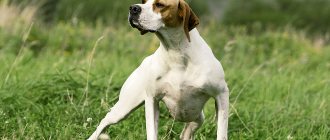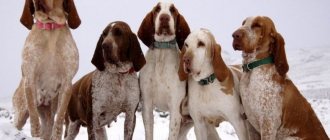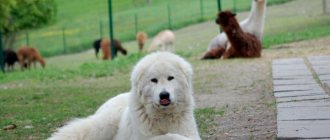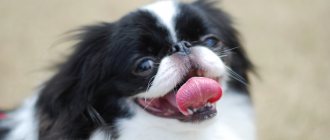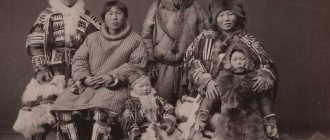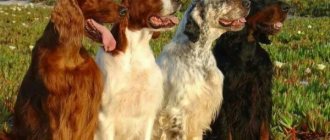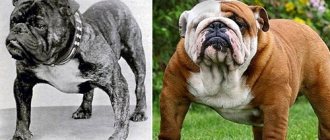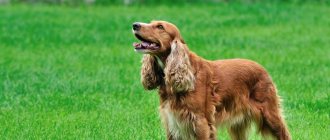Breed characteristics
| Short description | |
| Origin: | Great Britain |
| Conditions of detention: | House with garden, apartment (with regular long-term walking) |
| Purpose: | Pointers, guard dogs, companion dogs |
| Color: | Single color: red, black, coffee, fawn; bicolor: coffee piebald, black piebald, yellow piebald, red piebald |
| Wool length: | Short |
| Adult dog size: | The height of females is 61-66 cm, males 63-69 cm, weight of males is approximately 25-34 kg, females - 20-29 kg |
| Average life expectancy: | 12-14 years old |
| Walk: | Twice daily walk required |
| Physical activity needs: | High physical activity needs (regular or daily exercise for more than 3 hours per day) |
| Fédération Cynologique Internationale (FIC) classification: | Group 7: cops; Section 2: British and Irish Pointers and Setters |
| Puppy price: | From 8,000 to 30,000 rubles. Without pedigree - 8000-10000 rubles, breed class - 15000-25000 rubles, show class - 30000 rubles |
Price
Hunting pointers are sold privately at a much lower price than breeders from a kennel. The price of a Pointer for 2022 in Russia ranges from 10 to 35 thousand rubles. A dog is more expensive if it has a veterinary passport and pedigree.
Note! If its cost is less than 10 thousand rubles, it cannot be purebred! Dogs whose exterior parameters are standardized by the ISS (International Canine Service) are expensive, especially those classified as hunting cops.
History of the origin of the species
History has known cops since the 16th and 17th centuries . There is no exact information when the breed acquired its modern appearance. Initially, Pointers were Spanish (stocky, short dogs), they were brought to England as a commodity. They were crossed with Foxhound, Bloodhound and Greyhound. The result was a wonderful hunting breed that easily tracked game and left its capture to the Greyhound and hounds.
After the advent of firearms, bird hunting gained popularity. It is believed that these cops were the first to take a pose to indicate the location of the game's bed. The name comes from the English word “point” - to indicate.
Field tests in 1800 showed that these pointers, in fact, cope with a highly specific task - searching for forest birds (grouse, hazel grouse, grouse). After this, the demand for the breed increased. Due to long-term training in this direction, at the moment Pointers can only hunt such game; they will not go into the water.
Since the 19th century, the breed has become popular in urban circles due to its good adaptability to apartment life. Artists often got such dogs, because the demand for paintings depicting hunting dogs is incredibly high.
Now the breed is not very popular and widespread. She has not yet lost her working qualities, but is gradually turning into a family and sociable one.
Brief historical background
The ancestors of the Pointer, presumably of Spanish origin, came to Great Britain at the beginning of the 18th century. Intense breeding work was carried out over the next two hundred years. Several dog breeds took part in the formation of the modern Pointer:
- greyhounds;
- Foxhounds;
- bloodhounds;
- English and Spanish setters;
- Old French braques;
- bulldogs, etc.
The appearance of Pointers has remained virtually unchanged since the 19th century.
Since the end of the 19th century, no new blood was added, and the breed was kept pure. It is impossible to establish an exact list of participants, since virtually no documentary evidence has survived. But the result was an excellent breed, which to this day is recognized as one of the best among hunting breeds. In England, these dogs are considered standard, classic and are a national treasure.
Pointers arrived on the territory of Russia in the middle of the 19th century.
In 1891, the first breed club for Pointer lovers was founded in London, and in 1897 a preliminary standard was developed, which has changed little to date. Three years later, the British Dog Trainers' Association designated these dogs as a separate breed. They received recognition from the world canine community in 1963. The English Pointer is included in the FCI register under the honorary first number in group 7 - pointers (subsection 2.2 - pointers). The current current breed standard dates back to July 28, 2009.
Distinctive features
Pointers are medium-sized, harmoniously built dogs with smooth body lines and a streamlined shape. Their body is elongated to form a rectangle. With a height of 61-69 centimeters they are light . But the standard separates two subtypes: up to 25 kg (light) and more than 25 kg (heavy). The sexual type is well expressed. Females are smaller and more graceful, males are larger and more muscular.
The latest standard was published in 2009.
- The head is wide, strong, close to a square, because the skull and muzzle are equal in length. A furrow is visible on the forehead. The stop is moderately pronounced. The brow ridges and the occipital protuberance are visible.
- The muzzle is upturned and blunt. Under the eyes not filled. The cheekbones are not pronounced, the cheeks are flat. The jaws are wide and strong, scissor bite The lips are soft, but not jagged.
- The nose is turned up, the nostrils are open and developed. The color depends on the coat, usually black, but light colors are also acceptable.
- The eyes are small, set wide. The color of the iris varies from light brown to dark brown.
- The ears are set high, hanging down and close to the temples. Quite thin, rounded at the ends. Length – average.
- The body is elongated, smooth, muscular. The loin is convex and short. The topline is sloping. The chest is wide and falls to the middle of the elbows. The neck is long, slightly curved, and there is no dewlap.
- The tail is thick, tapered towards the end. Length is average. Set at lumbar level, does not rise higher when active.
- The limbs are straight, strong with developed muscles and pronounced joints. The paws are round with pointed toes. Movements are easy.
- The coat is short, hard, fine, and well distributed throughout the body.
- Colors: solid, spotted and tricolor. The most common colors are black and white, orange and white, liver white and lemon white.
Interesting Facts
The English Pointer is living proof that in the history of any breed you can find many interesting facts:
- The name of the breed has British roots and translated into Russian means “arrow” or “standing.” This fully reflects the specifics of the work of English Pointers. When tracking game, dogs move in a smooth quarry. And after discovering prey, the animals take a characteristic stance. They align themselves so that the muzzle, back and tail form a single horizontal line, and lift the front paw.
- The most famous English pointer is a dog named Judy. Since 1936, she lived on board the British boat Gnat and, together with the crew members, survived the battle of Singapore and the sinking of the ship, was in Japanese captivity and participated in the passage through the jungle, which took a month and a half. For his dedication and saving the lives of team members, the dog was awarded the Mary Deakin Medal.
- English pointers are much more vulnerable than representatives of other hunting breeds. The short, smooth coat of dogs does not protect them from dry branches and sharp thorns.
Photo of an adult dog
Photos of puppies
Features of character and behavior
This breed was developed in England . It’s no wonder that all the stiffness and aristocracy was passed on to the pets from these people. Pointers are balanced, calm, and polite. At the same time, they are characterized by activity and playfulness. They completely change their appearance during the hunt, where they can show all their talents and show their best sides.
They are completely devoted to the family and can serve as a guard if the situation requires it. Very smart, amenable to training and education. But it is worth considering stubbornness.
Advantages
- Calm, phlegmatic.
- They are not characterized by sudden changes in mood.
- They are friendly and warm towards their family, love children and tolerate all their pranks.
- They are wary of strangers, but only show aggression if they are not properly raised.
- They get along with pets, but this does not apply to birds.
- They have excellent hunting dog abilities: scent, hearing and vision.
- Fast and resilient, they can work for a long time without getting tired. Suitable as companions for sports activities.
- Smart and obedient, easy to train, do not try to dominate their owners and other dogs. They perform well in agility.
Flaws
- Pointers are not multifunctional. They are trained and raised as cops - they hunt only birds, at the sight of whose carcasses the pet freezes in a characteristic pose. They won’t chase hares, foxes or dive into water, which, by the way, they don’t like. They do not tolerate low temperatures well and are not intended for outdoor use.
- Very active. They need constant physical activity and walking. Proper training is also necessary to avoid deterioration in character and the predominance of aggression.
- Stubborn, not everyone can cope with a phlegmatic character. They do not feel their size and may accidentally drop or push the child.
Owner reviews
Eugene
I have had so many different breeds of dogs and English Pointers are the best. They are so funny! Pros: calm, sociable, positive, love to watch TV and sleep 10 hours. Cons: Need a lot of exercise, it is advisable to have your own yard where the dog can walk. If he doesn't have enough activity, he starts hunting shadows!
Ilya
If you're looking for someone to run with in the morning, get a Pointer! A very hardy breed. The ideal companion for adventures. This dog will always keep you in good shape.
Basil
I always go hunting and take my pointers with me. Males are more resilient, but they are more difficult to train; they strive for leadership and training takes a lot of time and effort. Bitches are much more pliable and can be trained better, but they are weaker and get tired much faster.
Maria
We recently bought a pointer dog. We live in a private house and have a child. The puppy is wonderful, we are going to take him to classes with an instructor so that in the future he will be sufficiently trained.
Anna
My father was a hunter, but due to his old age he stopped doing it, but now he breeds pointers on private property. There are always many people who want to buy a puppy.
Alexander
I am a long-time dog breeder and consider the English Pointer to be the best dog. I have been keeping these dogs for 20 years now and I doubt that any other breed can compare with them in terms of characteristics. Now I am the owner of two adult dogs and one puppy, all of them are selected, purebred, a real pride of their breed. I am sure that they will satisfy all lovers of beautiful, hardy and active dogs.
Dmitriy
For 18 years, my life has been closely connected with raising pointers. Males are stronger than females, but they are less amenable to training and constantly strive for leadership. Bitches are calmer and quicker to command, but are not suitable for working in difficult places. During the period of estrus, hunting is not allowed.
Sergey
I have this wonderful pet. I run in the morning and do active sports. And my dog is always happy to keep me company and, to my surprise, very rarely gets tired!
Video
Care and maintenance
This is an unpretentious pet that will adapt to any living conditions . But such a dog cannot be kept on a chain or in an enclosure, where it will miss its owner and mope. If the animal is an apartment animal, it is important to provide it with regular active walking.
Before buying a puppy, you need to make sure that there is enough space in the house for another full-fledged family member. The place for the pet should not be exposed to drafts or heated by direct sunlight. They buy a comfortable lounger, bowls with legs, toys, and hygiene products.
Nutrition
English Pointers are agile and strong. To replenish their energy supply, the diet must be based on protein foods. If it is dry food, the choice should be made on special products for active medium-sized breeds with a high protein content. Holistic (grain-free) super-premium ones are best suited. You need to carefully study the composition of the food so as not to cause indigestion or allergies.
Usually, breeders advise future puppy owners of a certain company whose food the dog was fed in the kennel. If you plan to switch to another product or natural food, it should be smooth. You can feed the puppy with the products that are in the composition.
Before use, food should be softened with water or broth.
Natural food is not as convenient as dry food, but it is familiar to the animal and is considered healthy. The basis of the daily menu is meat (chicken, lamb, veal, rabbit), you cannot feed your pet by-products alone . Cereals cooked in water or broth are important for the body.
- 3-4 times a week you need to feed them with vegetables and fruits.
- In addition, low-fat fermented milk products and eggs are given 2 times a week.
- You can feed fish, but only sea fish and without bones.
The following products should absolutely not be given:
- Floury and sweet;
- Smoked and fried;
- Pork;
- Butter;
- Potatoes and other starchy vegetables and fruits;
- Boiled and raw tubular bones (poultry);
- Nuts and legumes.
You can feed such a dog 2 times a day , puppies more often - 4-5 times . The serving size depends on the activity of the pet, usually 600-700 grams of dry food per day is enough. A vitamin complex is necessary in case of natural feeding. The veterinarian will help you decide on the right medications.
Health
Pointers are healthy dogs with strong immunity. They live a long time for a breed of this size – 12-14 years. Some individuals overcome the fifteen-year mark. To maintain good health, you need to follow all the rules of keeping, follow the vaccination calendar and regularly visit the veterinary clinic to examine your pet.
Vaccinations
To avoid infection with viral diseases, which are especially dangerous for puppies and pregnant bitches, the English Pointer must be vaccinated regularly.
- Vaccination begins at 1.5-2 months , the first vaccination is usually carried out in nurseries.
- Repeat the procedure after 2 weeks, consolidate at 6 and 12 months .
After this, the vaccination requires annual renewal. The drug is complex, provides immunity against mumps, hepatitis, parainfluenza, enteritis and other infectious diseases.
The second important vaccination is against rabies, which is done when the puppy reaches 7 months. Without this vaccination, taking a dog abroad is prohibited. It will also help avoid long-term treatment for the owner if the pet bites him.
All procedures are carried out in veterinary clinics by experienced specialists. Weak, sick animals and pregnant bitches are not allowed to be vaccinated. Before the second vaccination, the puppy cannot be walked; after each vaccination, it must be quarantined (2 weeks).
The cost of vaccination varies from 400 to 1000 rubles. Some breeders are convinced that as long as the puppy is not walking, he does not need vaccinations. In fact, millions of microorganisms, including viruses, are carried on human clothing and household items. To protect the animal, vaccination must be timely.
Diseases
Some hereditary and acquired diseases appear at different ages. The main problem of the breed is skin diseases and dermatitis. In addition, eye problems often occur: corneal deformation, cataracts, retinal atrophy.
Diseases that are often diagnosed in the breed:
- Arthritis;
- Hip dysplasia (production of defective cells, which leads to lameness, bending of the limbs and acute pain);
- Epilepsy;
- Deafness.
Walk
These are very active dogs. Of course, the best walking will be real hunting of game, for which the breed was bred. If it is not possible to organize such events, then taking your pet to the forest or planting is suitable, where it will splash out its energy to the fullest.
In any case, they need walking twice a day for 1.5-2 hours. They make excellent running or cycling partners. Of course, the pet will feel best in a country house, where it can freely walk around the fenced area around the house.
Pointers are not large, but can be antisocial and aggressive without proper training.
Grooming
It is easy to care for such a pet. They are short-haired, so they do not require frequent bathing, haircuts and brushing.
- It is enough 2-3 times a week, massaging the skin (animals really like this).
- Shedding is moderate, active hair loss occurs in autumn and spring.
- These dogs are rarely bathed - once every six months . In case of contamination, you can rinse in warm water without shampoo or wipe with a terry towel. Particular attention should be paid to the skin; it needs to be examined daily, because there is a tendency to skin diseases.
- your ears and eyes a couple of times a week. If you notice any unusual heavy discharge, you should consult a doctor.
- Teeth begin to be brushed after the final change of milk teeth. This can be done with a soft brush and special toothpaste or chewing cords.
- Paws are washed after every walk. Claws are usually trimmed in winter, when they do not grind down on the asphalt.
- Treat monthly for ticks, fleas and worms.
Nutrition
The Pointer is an active and cheerful dog that moves a lot. She should be fed high-quality dry food or natural food. Here is a list of recommended dishes for it:
- Boiled buckwheat with chopped chicken fillet pieces.
- Chicken eggs.
- Milk porridge, for example, rice or millet.
- Fruit puree.
- Berries.
- Offal.
- Soup, borscht, solyanka (not very fatty).
Never give this animal sharp bones or cartilage, as they can scratch the throat, causing severe pain in the mouth. A Pointer puppy should eat plenty of protein and carbohydrate foods to help strengthen its skeleton and muscles.
He also needs a balanced diet to process food components into energy, and the baby cop moves a lot and often. The following should be permanently excluded from his diet: sour berries, fatty fried foods, smoked foods, sweets, especially chocolate.
Mating
- Mating should not take place in a cramped room. If the dog’s territory is not spacious enough, then the pets are brought together in neutral conditions. A specialist is usually invited to resolve the issue.
- These dogs reach sexual maturity early, at about 8-10 months. But the body is fully formed only by 20-25 , so bitches cannot be bred for the first heat. The most favorable days are considered to be 13-15 from the beginning of the third heat.
- If the bitch is a breeding dog and there are pedigree documents for her, then a certificate for mating can be obtained from the nursery . A male is selected in advance. Both animals need to be rid of worms and fleas and examined for pathologies.
- Pets are introduced. To do this, they are either walked together or given 15-20 minutes to sniff each other. Sexual intercourse lasts 10-15 minutes, during which time the bitch is held by the head and under the belly, and the male is directed into the noose. The second fixative mating is carried out two days later.
Key points in training
The Pointer is a serious breed that requires not only basic education, but also highly targeted training.
- They tend to be stubborn, but show good results in agility. Beginners will not be able to cope with the character of such a pet. If problems arise, you should contact special training schools.
- The Pointer must take the Dog in the City adaptation course. If you plan to raise a puppy as a hunting puppy, you need to seek the help of specialists.
First of all, the puppy is taught the rules of behavior in the family and on the street, to build a hierarchy, to show that the owner is in charge. The use of brute force and insults is not recommended.
- The dog must know its daily routine, place and name well.
- In addition, it is necessary to achieve perfect execution of the basic commands: “Near”, “Place”, “No”, “Voice”, “Sit”.
- Read about how to properly train a dog in the article: “Training a puppy: effective methods from dog handlers, learning commands at home.”
How to choose a puppy
The Pointer is not a common breed, but it won’t be difficult to buy a puppy . One question: in a nursery or from a private person. An official breeder will provide all documents and guarantee purebredness and good health. But buying a dog from a private person will be cheaper.
- You need to find out everything about the conditions of keeping the dog: daily routine, nutrition, food.
- Get advice on choosing hygiene products.
- If possible, you need to look at the parents, evaluate their temperament and appearance.
- Healthy puppies will be playful and curious.
- Must fully comply with the characteristics and have no obvious congenital pathologies.
The average price is 20,000 rubles. Without a pedigree it will cost 10,000-15,000 rubles, and a show-class pet will cost 30,000 rubles.
The Pointer is a wonderful dog with a reserved English character. She still has working qualities and can easily serve as a hunting dog.
2.8 / 5 ( 5 votes)
Diseases of the English Pointer
Pointers are hardy and strong animals with good health and strong immunity . The diseases that await them along the path of life are most often associated with errors in maintenance and care; no specific hereditary pathologies are characteristic of this breed. On average, these cops live up to 11–13 years, but some individuals exceed the mark of 15 years.
No more often than other canines, they suffer from diseases of the musculoskeletal system (arthritis, articular dysplasia, etc.), skin diseases, and eye problems (glaucoma, cataracts, etc.).

